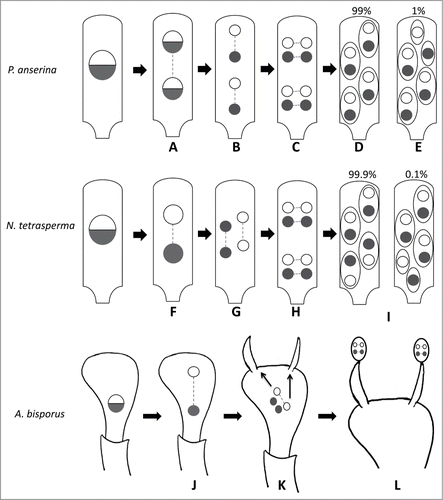Figures & data
Figure 1. Creation of mating type heterokaryosis during sexual reproduction in P. anserina, N. tetrasperma and A. bisporus. For the 3 species, at meiosis I, the spindles are aligned in the longitudinal axis of the ascus for P. anserina and N. tetrasperma or of the basidium for A. bisporus. (A) In P. anserina, the mating type locus undergoes 99% of SDS. (B) In meiosis II, the spindles are aligned and oriented in the same way as in meiosis I. (C) After meiosis, a post meiotic mitosis occurs for which the spindles are parallel and oriented across the ascus. (D) The ascospores are formed within the ascus, each one engulfing 2 non-sister nuclei. (E) About 1% of the asci show abnormal spore formation where 5 ascospores are present, 2 of them carrying only one nucleus. (F) In N. tetrasperma, the mating type locus undergoes FDS. (G) In meiosis II, the spindles are parallel and partially overlapping. This overlap leads to the same situation as in P. anserina after meiosis. (H) A post-meiotic mitosis takes place in the same way as in P. anserina and (I) the ascospores are also formed around 2 non-sister nuclei and rare 5-spored asci may be obtained. (J) In A. bisporus var. bisporus, the mating type locus likely undergoes FDS. (K) In meiosis II, the spindles may be in the diagonal of the basidiumCitation38 as depicted here or adopt other conformations.Citation13 After meiosis, 2 non-sister nuclei migrate preferentially through the sterigamata to the basidiospores.Citation15 This may be facilitated by the fact that the second meiotic division is not synchronous for the 2 nuclei issued from the first meiotic division.Citation13 (L) The 4 nuclei undergo a post-meiotic mitosis into the basidiospores.

